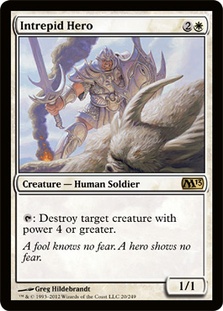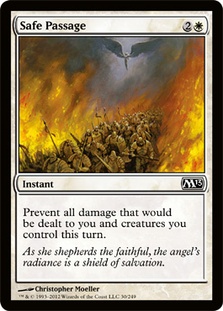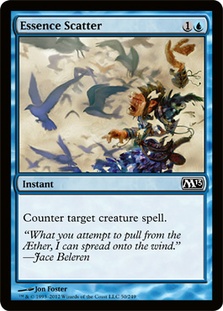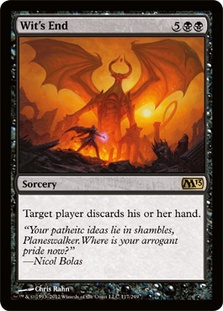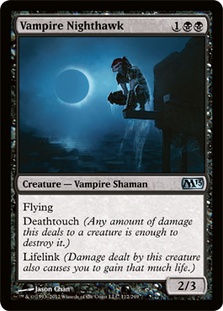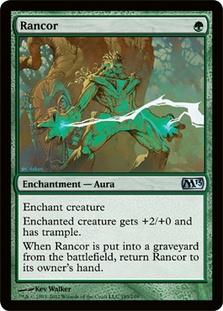I decided to take a kind of different look at about ten “new” M13 cards. “New” in quotes because while they are new to Standard legality, all these cards are reprints. No, I am not going to go over all the reprints or even go over the ones that I chose via a conventional “review” style. Rather, I am going to do two things: 1) take the long view and 2) try to imagine situations where these cards can be difference-makers.
Difference-makers in Constructed formats are sometimes (but not “usually”) the flagship-type cards of a deck. They aren’t necessarily flashy and the major incentive to playing a deck or even good all the time or against every matchup. Rather, they are the cards that can give a deck the edge over itself or change the matchups (especially unexpected ones) in strange or unconventional ways.
An example might be a card like Turnabout. Those of you familiar with relatively “recent” (being in the last year or two) High Tide decks in Legacy probably think of Turnabout as a staple of the archetype; the Hatfield deck that won the 2011 SCG Legacy Open in Edison played three Turnabouts and sided the fourth to access with Cunning Wish.
But when High Tide debuted at Pro Tour Rome, Turnabout was played in Federico Dato’s Top 4 list… But not every list.
Turnabout wasn’t the core of the High Tide incentives (Time Spiral was), but it did two big things for the deck. For one, you could play it to tap down an opposing blue deck (they either countered it, so it was an end of turn Duress) or they got tapped out (which was great if you wanted to go off). Plus Turnabout gave you a new and fast option to go off on the third turn (Tap Island #1 for U casting High Tide, tap Islands #2 and #3 for UUUU to Turnabout and untap your lands, giving you six for Time Spiral).
Just a week or two ago I dusted off the B/R Thought Experiment that I talked about here. I added Incinerate as a redundant removal card that could also interact with Garruk Relentless and other planeswalkers and was excited to see if the deck could go somewhere having shored up that weakness. My very first outing was a long grind against a white-based control deck. After 50 or so turns he finally showed me White Sun’s Zenith. Forget about the fact that there were a nearly lethal number of Cats in play; I realized I could probably never beat a single White Sun’s Zenith…if nothing else it would keep him from ever decking!
So this time around, the goal is to look up some older decks where some of these cards contributed in the past and try to imagine some spots where they might be productive today.
Intrepid Hero
Example Deck
Creatures (26)
- 4 Llanowar Elves
- 3 Exalted Angel
- 4 Birds of Paradise
- 4 Anurid Brushhopper
- 4 Wild Mongrel
- 3 Glory
- 4 Ravenous Baloth
Lands (23)
Spells (11)
Sideboard

Hall of Famer Gary Wise played a solo Intrepid Hero in the sideboard of his 2003 Beasts deck. While this might not seem immediately strategic to some of you, I think we can all agree that Intrepid Hero—given its size, speed, and relative narrowness—isn’t necessarily the kind of card you want to be drawing in game 1 maindeck.
But Gary was playing a “Wish” sideboard of many bullets, essentially paying a 1G tax for the privilege of playing four copies of Intrepid Hero maindeck, as well as four copies of Silklash Spider (and six copies of Contested Cliffs).
Intrepid Hero in 2012
At 1/1 for three mana, I am not sure I want to be playing Intrepid Hero in the main…but I can imagine lots of times I might want it in my deck!
First and foremost, it is a three-mana creature in white. White can go after solo threats of any stripe with Oblivion Ring for three mana and sweep with Day of Judgment. If you are accessing a card like Intrepid Hero, chances are the reason is that you are a creature deck; ideally you want to be hitting this on the second turn with a setup man like Avacyn’s Pilgrim. Basically, you want to get an advantage over [other] creature decks, possibly gaining tempo or card advantage, shutting off the opponent’s strategy, or just keeping them from beating you up with their bombs.
What if the opponent’s breaker is a Wolfir Silverheart? All of a sudden you might have a card on three that can answer any number of his fives (if he can’t remove a 1/1). Blessings of Nature and Revenge of the Hunted are two new miracle cards that have themselves proved difference makers in MGA and Infect. Leaving an Intrepid Hero up can prevent the opponent from taking advantage of them.
Completely shuts off a Runechanter’s Pike for as long as the other guy is willing to let it sit there; how many games in the last month or so have you lost to any old guy + a Runechanter’s Pike?
I’ve lost count, too.
Safe Passage
Example Deck
Spells (32)

Safe Passage in 2012
Turbo Fog is maybe even more of a metagame choice than Beasts!
There is probably nothing stopping you from trying a Turbo Fog with more modern card drawing options, but that isn’t really what made me want to point out Safe Passage…
But what about as an answer to Bonfire of the Damned?
Safe Passage can play Counterspell (conditional) in decks and colors that can’t normally stop a Bonfire of the Damned (say the Naya mirror).
There are certainly some drawbacks to this card (it costs three mana, kind of like a Dissipate, but without most of Dissipate’s utility), but I think Safe Passage is the kind of card that if you are bringing it in, you will find something to do with it. Like say you haven’t been blown out by Bonfire of the Damned (well, conversely, you haven’t wiped the smug look off your Bonfire-attempting opponent’s face yet)… You can certainly set up blocks to “trade” but just one-sided Wrath your opponent. You can rob him of lifelink. Heck, you can just buy a turn with your back against the wall (maybe you are stalling to find your own Bonfire).
No, it doesn’t seem that “put me straight in, coach” on its face, but I think that you find more and more interesting stuff to do with it once you have stuck yourself with it.
Serra Avenger
Example Deck
Creatures (16)
Lands (23)
Spells (21)
- 4 Wrath of God
- 1 Confiscate
- 2 Boros Signet
- 4 Compulsive Research
- 4 Lightning Helix
- 2 Azorius Signet
- 4 Demonfire
Sideboard

I wrote the Top Decks preview for Serra Avenger back when it was new the first time, and then—thanks to my friendship with the great deck designer Brian Kowal—was able to spike a nice win with my first outing with it.
Despite some fairly insane value (3/3 flying for two mana), Serra Avenger never really took off as a go-to centerpiece card. Maybe got some play in the White Weenie decks that didn’t actually do well in the Time Spiral Pro Tour, some arm-in-arm with Aether Vial in Legacy to the tune of a GP Top 8 or so…but never the kind of week-in / week-out relentless Top 8 performance you see out of a Delver of Secrets, Tarmogoyf, or Strangleroot Geist.
So what’s the problem with Serra Avenger?
I think that more than the turn condition (which isn’t all that bad for Standard as you can just play Serra Avenger with 1U up on turn 4 to cover with any of a bazillion Remands, Mana Leaks, or Negates depending on the specifics of the format), the WW specific casting cost is a weight around its neck. I think at 1W it would be a completely different card and might have come up with quite a different palette of takers. It’s not just a matter of perception, of course: the number of decks that can reliably produce WW on turn 4 are limited.
Serra Avenger in 2012
I think there is space for a white-based midrange deck in Standard. The new Ajani is an intriguing option, and the deck can spread to black for Lingering Souls and a surprisingly-not-painful Dismember splash (at least in the near term). The white midrange deck would demand on-curve tapout less than a true White Weenie, but might arguably have more tolerance for the speed and stats on Serra Avenger, which are excellent.
Of course, if you want to go pure White Weenie there might be an argument for Serra Avenger. Magic is getting to a point that cards are all about the same cost / power level regardless of what turn you are playing them (Delver is deadly on turn 6 with its namesake one-drop as a topdeck-and-play, even though it is not a Titan), and it is hard to imagine a better two-drop in White Weenie than this. You just have to make sure you can fill your 2 and 3 with a Thalia or so to bridge the turns. It should go without saying that a three-power flyer that you can potentially play with three mana open is a useful asset, even defensively, against cards like Delver of Secrets and Geist of Saint Traft.
Essence Scatter
Example Deck
Creatures (9)
Planeswalkers (2)
Lands (26)
Spells (23)
- 3 Broken Ambitions
- 4 Cryptic Command
- 2 Negate
- 2 Hallowed Burial
- 3 Cruel Ultimatum
- 4 Esper Charm
- 4 Volcanic Fallout
- 1 Essence Scatter
Sideboard

Maybe we are reaching a bit with Gindy’s 1+1 on Essence Scatters here, but US Nationals can be a name-making win and even as a role-player, Gindy showcases some opportunity and appropriateness here. Check out what’s there, and what’s missing? Gindy had some Negates, but his leadoff Counterspell was Broken Ambitions. Simply…this was a deck without Mana Leak access.
Essence Scatter in 2012
We know R&D considers Mana Leak too good, and lo and behold, like the Titans (and Day of Judgment!), Mana Leak is missing from the M13 reprints. Blue control is going to have to run something as a defensive two, and it looks like it is going to be a split between Essence Scatter and Negate (as in the above list).
Maindeck Essence Scatter is just going to be a fact of life, especially with Murder replacing Doom Blade and Go for the Throat soon. Yes, your draws are going to be uneven much of the time, and yes, Mana Leak spent games 2 and 3 in the sideboard even when it could be countering creatures at [mana] value.
But what else are you going to do?
Duress
Example Deck
Creatures (9)
Lands (23)
Spells (28)
- 1 Eradicate
- 4 Vampiric Tutor
- 4 Yawgmoth's Will
- 1 Persecute
- 4 Duress
- 4 Dark Ritual
- 1 Stupor
- 1 Perish
- 2 Unmask
- 1 Engineered Plague
- 4 Vicious Hunger
- 1 Massacre
Sideboard

Now speaking of US Nationals being a big win, there you go: the bestest US Nationals deck of them all (just one man’s opinion).
The important thing here is to illustrate that once upon a time Duress maindeck was a thing: a big, four-of thing. Almost every black deck went there, and in Extended, it was very common to see 7-8 copies of Duress + Cabal Therapy in every single deck that could consistently make black, not just in “black decks” (B/U Reanimator, B/G The Rock, Suicide Black obviously).
Why did we drift away from so many maindeck Duresses?
Well, drawing discard off the top in topdeck mode isn’t necessarily the best, and creatures got faster and more consistent. When Duress was at the height of its popularity, it was contending with efficient counterspells (like, you know, Counterspell) and when it was first printed people could play things like Yawgmoth’s Will, Tinker, and Yawgmoth’s Bargain. Even later, in Standard, you had decks trying to kill you with nothing but a sequence of Corrupts or—once in a while—a legitimate combo deck.
As long as you have decks like Martin Juza’s Naya that is all creatures but for four copies of Bonfire of the Damned (that are going to be played on draw, i.e., almost never exposed to a potential Duress), this highly efficient and decorated card is going to miss quite a few game 1s. Like almost all of them.
Duress in 2012
I am doubtful that we’ll see a huge adoption of the card in maindecks. That is largely going to be a self-preservation thing; you just can’t afford to draw it with your back against the wall to Juza’s deck or decks like it.
That said, I think it will probably be a fairly important sideboard card. If the conditions are that we stopped playing it [so much] as creatures got faster and more popular, then surely the answer is that it will shine whenever you can position it strategically. I particularly like how you can play Duress on the first turn if you want…but also wait to play it on the turn before your opponent plans to drop his bomb planeswalker. Especially if your big game is Nicol Bolas, Planeswalker, you might need to buy 1-2 turns against an opponent with the faster Karn Liberated.
Doubly cool is when you can do both!
Duress—as a one-mana spell that can have a dramatic effect on the outcome of a game—makes for a pretty big game with Snapcaster Mage!
Wit’s End
Example Deck
Creatures (10)
Lands (23)
Spells (27)

Wit’s End had a special spot in the war of haves versus have-nots at Pro Tour Charleston; as you can see, the winning squad played it. This was a the only ever Unified Constructed Team Pro Tour so you had some differing limitations and incentives. Believe you me, if your board control deck got paired with their board control deck and only one of you was playing Wit’s End… The guy one the wrong end of the equation had best prayed for mana screw.
Wit’s End in 2012
M13 seems to have a curious glut of useful cards whose primary purpose is “side in to crush control decks without permission.” Thing is, there is no one “best” at this simply because there is no real unification on colors. A deck with Nicol Bolas, Planeswalker can almost necessarily play Wit’s End, but a Wit’s End is faster and might just send Bolas to the bin, heads up. Battle of Wits is quite a bit faster (and more potent when it works), but that card is available only to blue.
I think it is needlessly reductive to ex Wit’s End purely on basis of its cost. I made that mistake in Charleston and Paul Jordan and Jon Finkel—playing our team’s Patrick Chapin-designed five-color control deck—suffered heads up against 3-5 color board control decks that did include it. Remember, Wit’s End is a scalpel, despite its cost. You want it in against decks where you have little risk of being blown out early, where you can hit seven lands, and where you have a high expectation of bomb cards resolving.
Just look at recent wins and finishes on the SCG Open Series. Control decks with little-to-no permission are a thing in Standard, from Esper Control to MBC…
@fivewithflores Thanks for the inspiration Mike, your meta read was right on, a pro pilot takes it down, SCG SEA Mono Black Phil Johnson.
— Phil Johnson (@BlackSkullMage) July 2, 2012
… And if you want to beat them consistently you need a different set of tools than to beat certain other viable strategies. At present, they are exploiting the ragged super-attention applied to Delver!
While I super appreciate the props from Phil (who just put MBC on the SCG Open Series map last weekend), the reality is he did most of the heavy lifting himself and fielded a substantially different MBC than I have been advocating. Point being there is a whole wing of control that is viable right now that is going completely unaccounted for from a metagaming perspective. It. Is. A. Thing. You can keep pretending it’s not a thing and completely miss the tools to beat it.
Ravnica era, Wit’s End was nigh unbeatable in the midrange mirror when that was a reasonably expectable matchup; though, to be fair, I don’t know how that maintains (or doesn’t) in the battlecruiser age of planeswalkers. Surely there is something to be said for having a hand when the other guy doesn’t if you both have planeswalker access.
Vampire Nighthawk
Example Deck
Creatures (6)
Planeswalkers (5)
Lands (26)
Spells (23)
- 4 Mana Leak
- 1 Cancel
- 3 Doom Blade
- 2 Disfigure
- 4 Spreading Seas
- 1 Consume the Meek
- 4 Inquisition of Kozilek
- 4 Preordain
Sideboard

For those of you just tuning in, U/B Control was THE deck of Worlds 2010, not only winning the event in the hands of Guillaume Matignon but racking up five copies in the Top 8. Now I really would have liked to showcase Vampire Nighthawk in the winning deck or even the finalist’s deck (because it was a mirror final between U/Bs and Guillaumes both), but neither Matignon nor his BFF / opponent Wafo-Tapa played it.
So I had to fall back on DI Top 8 competitor PV at 3rd to highlight the Nighthawk I wanted.
There are other Nighthawks, sure; even maindeck Nighthawks! It is a Vampire, of course, and was played in Eric Froehlich’s Vampires deck for example. But the Vampire Nighthawk I like best is the one that waits in the wings of the control deck and comes in to do a bunch of different jobs.
Vampire Nighthawk in 2012
Incinerate is the first thing I want to address. That is, almost no one plays it. You need your Shock variants like Galvanic Blast to match the speed of Delver of Secrets and Pillar of Flame against Strangleroot Geist. Even straight red decks have been going other directions. Geistflame for value or Gut Shot to set up Stormblood Berserker, maybe morbid fives, and maybe proliferation on three (and on three)…or maybe not; sure, maybe Incinerates (but probably not). Given the available tools and threats, there is just more incentive to two-on-one than three-on-two (or three-on-three), and in a world of one- and two-damage burn packets, Vampire Nighthawk is not only poised to live but to accomplish something!
I was one of the first players to side in Nighthawk against Boros or burn decks with my Grixis three years ago (you can dig up the debates between YT and GerryT here and elsewhere). I was dissatisfied with Dragon Claw’s do-nothingness on the table and realized eventually that I could get a lot of the effective punch of a Dragon Claw with more upside going Nighthawk. Even if it only got in once and then drew a burn spell (or two), that was like four turns of Dragon Claw, and again, you might just kill someone (or you might have a Countersquall in the right spot). Against a burn deck its range was anywhere from “legit Lightning Rod” to “Wit’s End that might kill them” depending on your relative draws, and anywhere on that spectrum can give you a position but the far end is fantastic (and probably even better now).
Now speaking of Wit’s End, Vampire Nighthawk also has some nice gamble to it. Like, just like a burn deck that wasn’t playing Incinerate (so probably won’t be playing Searing Spear), your fellow control players might not be able to kill it easily either. Victim of Night? Doom Blade? Sure, the matchup with Liliana might not be great, but there is certainly something to be said for putting the other fella on his heels in an unstable (and likely removal-poor) situation. One of the best sideboarding strategies for control-on-control is to reposition yourself as aggro-control, and Nighthawk is a viable avenue.
Plus, fine Vampire and all that.
Nicol Bolas, Planeswalker
Example Deck
Creatures (6)
Planeswalkers (1)
Lands (27)
Spells (26)

Before he was US National Champion, Ali Aintrazi was already making waves with his slow control decks by doing stuff like playing Nicol Bolas instead of Jace, the Mind Sculptor (or more, cheaper, Cruel Ultimatum).
The deck here is purely for precedent’s sake: Nicol Bolas has proven good enough for big formats already, either as a compliment to or proxy for one of the most defining Stage Three threats of all time.
Nicol Bolas, Planeswalker in 2012
I think the spot is similar to 2010 and so. Big threat, high end, trump the kids going for natural card advantage. Bring death and doom.
The challenges are twofold: 1) There are already super expensive planeswalkers people play (e.g., Karn Liberated) and 2) Delver of Secrets & co.
Karn is faster, but depending on what the opponent does (and who went first), Bolas might just go over the top of Karn. The bigger issue is that you probably play two Bolas max and you certainly don’t want to lose one directly to Karn. It’s hard to argue anyone playing higher power though.
Delver—true aggro-control really—is a tricky question. Aggro-control has a natural advantage against true control (but not necessarily board control). You are obviously in black and red already; it’s quite possible you can kill all their guys and then resolve Bolas. You will probably have to bleed them first because as long as Mana Leak is legal, you are going to need double digits and Delver is going to have Negate / Dissipate access regardless.
Still, something to be excited about!
Rancor
Example Deck
Creatures (18)
Lands (20)
Spells (23)
Sideboard

I included Trey’s GP-winning deck to set a tone. Rancor is obviously a serviceable StOmPy card and probably hell on a Glistener Elf, but I feel like the card was at its best in something like the Three-Deuce where it elevated a relatively thin count of green creatures to becoming capable of besting full-on Trix (the most feared combo deck of all time, with good reason) at its height.
Rancor, then, can be thought of as a cerebral enhancement, not just a blunt instrument; Sword-like yet incredibly cheap and tough to handle. It’s the kind of buff you want a Birds to wear. And when the Birds plays Lightning Rod (as it inevitably does), you get the damn Rancor back.
Rancor in 2012
I make a lot of fun of Thrun. Never since Greg Oden being drafted over Kevin Durant has there been a more disappointing big initially commanding such early laurels. First it’s you can’t counter, Jace, or Day it…then reality hit in a flurry of feathers, tokens, and Edict effects. Oh, and like 100 kinds of Clone, all cheaper.
Sure, you spike a Thrun seemingly out of position and it sucks that they have Tribute to Hunger or Liliana; but more than half of Thrun’s disappointing performances have come from being blocked by 1/1 Squadron Hawks, then Spirit, Soldier, and even Goblin tokens.
With Rancor Thrun might—just maybe—cobble together two months or so of glory or at least relevance. It’ll be like when Drexler joined the Rockets and a sixth seed won it all; don’t worry, MJ doesn’t come back-come back until next year.
Also awesome with Geist of Saint Traft and especially Inkmoth Nexus. REALLY especially awesome with Ichorclaw Myr! Sorry Balloon Pants, with a little color work, Rancor is the name of the creature enchantment Invisible Stalker will be crying out at night from now on.
Battle of Wits
Example Deck
Creatures (4)
Lands (92)
Spells (148)
- 4 Counterspell
- 4 Chainer's Edict
- 4 Urza's Rage
- 4 Duress
- 4 Exclude
- 4 Sleight of Hand
- 4 Diabolic Tutor
- 4 Memory Lapse
- 4 Terminate
- 4
- 4 Insidious Dreams
- 4 Compulsion
- 4
- 4 Chromatic Sphere
- 4 Concentrate
- 4 Sky Diamond
- 4 Marble Diamond
- 4 Charcoal Diamond
- 4 Disrupt
- 4 Hobble
- 4 Dromar's Charm
- 4 Wild Research
- 4 Prophetic Bolt
- 4 Yawgmoth's Agenda
- 4 Void
- 4 Repulse
- 4 Recoil
- 4 Probe
- 4 Opt
- 4 Fact or Fiction
- 4 Addle
- 4 Absorb
- 4 Tainted Pact
- 4 Syncopate
- 4 Peek
- 4 Innocent Blood
- 4 Battle of Wits
Sideboard

I really hope Huey Jensen makes the Hall of Fame this year.
Forget about the fact that Jon has him at Bob-level or better and that if pretty much all of the consensus best players of all time all say he should be in, everyone else should probably shut up for ten seconds and put him in, especially if they have zero frame of reference for the span of his greatest activity. Forget about the fact that Osyp Lebedowicz recently pointed out on Twitter that if they had changed the Legend Rule about 15 minutes earlier Huey would be a two-time PT Champ (Osyp beat Huey to Akroma locking his hand in the semis of Venice). Sure, I’ve personally voted Huey several times and written about it more than once. I was once upon a time a Top 25 rated Limited player and only managed to defend my ratings invites due to lucking into sharing flights with William Jensen on the way to PTs I was woefully unprepared for.
Forget about all that.
How many other players of any significance made any finishes of any significance with a 244-card deck?
Fine.
Be that way.
Jon Finkel also went undefeated in the Standard portion of an Invitational with a different Battle of Wits deck (you can see it here).
You realize that 30 seconds ago you were dismissing Battle of Wits in your imagination, and now you are coming to the realization that in the face of Psychatog + Upheaval what two of the greatest players of all time were capable of doing with it.
And sorry, trolls, Jon’s deck is only two hundred forty-one cards.
Battle of Wits in 2012
This is probably the single most exciting card in M13 from my perspective.
If you step away, for a moment, from your Mono-Delver myopia you might come to realize that Battle of Wits is a one-card combo that can “go off” on turn 4 or so.
You know all those no-counters control decks we have been pointing out? How exactly are they supposed to beat this thing game 1? It’s faster than a Wit’s End or basically any planeswalker ultimate.
The possibilities on how to build a Battle of Wits deck are expansive, in part because you have 200+ cards to work with. A reprint I didn’t highlight individually is Farseek. Forgetting about any shockland speculation for now, Farseek is at the very least going to put Sphere of the Suns out of business in the G/x Ramp decks, and in Battle? Why not play all twelve if you are going to go green for acceleration?
Battle decks have their own rules.
You need to have 200 cards in your deck when you go off, but it is unclear how many cards above 200 is optimal (Huey played 244 versus Jon’s 241). It’s important to think about whether you are digging for your Battle or if you can Tutor and Wish for it (Finkel could Burning Wish for Diabolic Tutor whereas Huey had access to Fact or Fiction).
The insane thing about Battle decks is that you can build with almost no conscience towards discipline. Curve? What curve? Huey played four copies each of Prophetic Bolt, Void, Urza’s Rage, Probe, and Yawgmoth’s Agenda…in addition to his Battles. I am curious if there is a viable Battle deck that has four copies of Nicol Bolas, Planeswalker as well as four copies of Karn Liberated.
Battle decks, you see, don’t have to win with Battle. They “can” win with a one-card combo, but they can also just play every kind of control deck the card pool allows. Is there a viable strategy in U/x? You can fit it in. You have 240+ cards to play with!
You always have more-sies.
You can probably have 50 or so kinds of kill spells (Huey played 48 main). How many threats does the other guy play again? Total?
Back before Mana Leak came back in M11, I never liked having Cancel in my deck, but I certainly liked Canceling my opponent’s “I win” cards when that came up. That one Cancel was sometimes consistently the best/worst card in my deck. I predict in the next two months many of you will contentedly Cancel a Delver of Secrets, Restoration Angel, or Primeval Titan and feel just fine about it. Your opponent will be mad for a second, look at the size of your stack, and shrug. Of course you played Cancel! It is your Dissipate 5-8! Obviously.
Why?
Because Battle is awesome.
Battle is Magic untethered.
Battle is freedom from rules with a tremendous “I win, now” upside. Battle is the last connection to the days before you knew with all your heart that 60 cards was-is the right number of cards in a deck, with no arguments, to the point that big winners are playing 12+ cantrips and paring lands down to the nineteen range as we speak.
Battle is a chance to let it all hang out…and get paid back for your complete lack of deck discipline.
Battle is like that time one of my buddy’s ex-girlfriends tried to convince me to go live on a commune with her. Whatever everybody else’s rules! (She was cute, but I didn’t).
Battle is so much fun.
For someone like me, whose operating system is to try to figure out what the best cards are and try to play the best cards in an unstable environment, Battle is jarring to my core belief system, except… 1) getting out of your comfort zone is good for any serious builder and 2) what if Battle is just one of the best cards? Breaking it is actually a fulfillment of the second clause. Are you sure Primeval Titan (which costs one more and isn’t blue) is really so much more powerful? What if you Ponder miracle into Temporal Mastery with six lands in play and a Battle in hand?
That’s what I thought.
Some Battle ideas:
- Dimir or Grixis Battle with every Think Twice, Forbidden Alchemy, and (if Grixis) Desperate Ravings possible. You dig Dig DIG to your Battle. You can (of course) fit a Burning Vengeance subtheme (obviously); plan here is to draw extra cards until you find Battle while killing all threats.
- Mono-Blue Battle – Might not have any incentive over B/U Battle, though colored mana gets to be a bigger question mark when we are talking about a limited number of dual lands stretched across a ~ 90-land mana base. Given that, I certainly can get behind playing every Divination, Amass the Components, high-end planeswalker, and Counterspell in the format. This Battle might just have a Grand Architect subtheme and defend itself with all the Batterskulls and all the Wurmcoil Engines!
- U/G/x Battle – As above, “accelerated” Battle… You can even go Birds of Paradise, Llanowar Elves, and Green Sun’s Zenith. Can you imagine the ability to Zenith for basically anything? Because, as a veritable Noah’s Ark, you can fit one of everything you could ever want. Have you ever thought to yourself, “You know what I need right now? A Kessig Cagebreakers.” Me neither! But finally you can try one! Incentive here is that with Rampant Growth and company, you have the fastest Battles in the field.
You will probably never lose to a Nephalia Drownyard.
It will be a thing.
LOVE
MIKE

